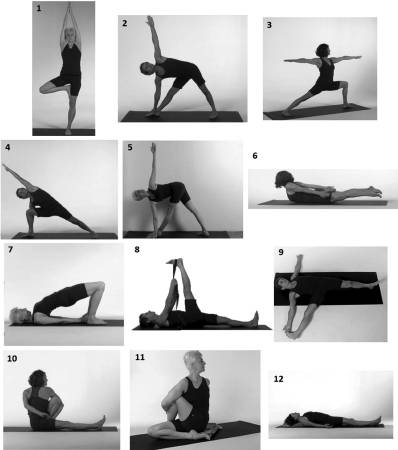
Hey Christian friend, if you practice yoga (or have thought about it), this post is for you. I’ve been doing yoga off and on for a few years with more consistency this past year. Recently, I’ve seen a movement within Christianity to label yoga as demonic. I’ve had acquaintances question my practice. I’ve seen social media posts and videos which call on Christians to stop using yoga as a form of exercise. All of this has led me to examine my own practice and take a deep dive into the origins of yoga. I thought this would be a simple post to write. “Christians – carry on!” But instead, I’ve found that the more I read and research, the more complicated things become. So let me walk you through my thoughts as I try to answer the question that’s been asked of me: Hey Christian friend – should you be practicing yoga?
WHY I TURNED TO YOGA
Years ago, I found myself so burdened by chronic disease and inflammation that I could not physically move my body. Sometimes I was too weak to walk around the block. At other times, I felt more energized, but when I tried to exercise, the resulting inflammation would send me into a flare. I turned to yoga because the gentle movements and strategic breath work were accessible to me, even in a weakened state.
MY PERSONAL YOGA OUTCOMES
I’m an obsessive list-maker who struggles to find moments of rest. I often fail to shut off the responsibilities and obligations that run through my head. If I sit down on the couch, I invariably feel a tug to jump up and tackle the next thing on my mental list. There’s laundry to be done, baseboards to be dusted, a homeschool closet to be organized, and always another project to write. I don’t rest well.

Practicing yoga has taught me that it’s important to shut off the part of my brain that is always working. Silence is restful, and being rested is integral to healing. My fight-or-flight response is calmed by quiet yoga practice. I’ve learned to focus on my breathing, which is naturally shallow. When I focus on breath work, I consciously move air throughout my body so that my stomach rises and falls rather than my chest and shoulders. Box breathing calms my anxious thoughts and steadies my approach to the world around me. Overall, the quiet breath work that I’ve learned through yoga may be the most beneficial aspect for me personally.
When I do yoga consistently, I feel physically energized. Often, when I enter the studio, my muscles are tight. I chronically carry tension in my neck and shoulders. Yoga loosens this tightness and leaves me feeling strong rather than bound. I often take a yoga class on Friday mornings before I spend the rest of the day writing. I’m more productive and more focussed on the days that I take that hour to rest, breathe, and stretch. I leave the studio feeling good in my skin. I feel proud of my body and connected to the way in which it functions. That’s significant for me since I used to feel trapped in my own skin.
MEDICALLY DOCUMENTED YOGA OUTCOMES
My yoga teacher likes to reference this particular study. Basically, holding these twelve yoga poses daily for one minute each has been shown to increase bone density. This is notable in that even osteoporotic bone loss was reversed in study participants.

Yoga is also thought to improve the lifestyle of people with depression and anxiety, decrease blood pressure in those with hypertension, and improve blood glucose numbers in people with diabetes. These outcomes, though, are less supported than the first study.
THE ORIGINS OF YOGA
If you spend any time reading about the origins of yoga, you’ll see that it was born out of Hindu tradition. According to archaeological evidence, yoga began in India as early as 3000 BC. The word yoga comes from the Sanskrit word meaning “to yoke or join.” Yoga was created to be a spiritual practice to unite the mind and body. Through this practice of discovering the “true self”, a seeker strives to make the soul fit for union with the oversoul – the Hindu god, Brahman. By attaining union with the true self/Brahman, the soul of the seeker is liberated from reincarnation (the endless rounds of rebirth and death) and karma (the law of consequence to every action).
YOGA IN WESTERN CULTURE
Traditionally, there are eight limbs to the yogi’s enlightenment of the true self. They are:
- Ethics (Yama)
- Discipline (Niyama)
- Postures (Asana)
- Breath Control (Pranayama)
- Withdrawal of the Senses (Pratyahara)
- Concentration (Dharana)
- Meditation (Dhyana)
- Nirvana/trance (Samadhi)
Many of these original eight limbs have been excluded in western yoga practices which tend to focus on postures (Asana), breath control (Pranayama), and mediation (Dhyana). In western culture, yoga is generally not one inclusive practice as it was created to be in India. There are many different styles of yoga practiced.
Hatha yoga is one style that is known for its gentle form, slow pace, and meditative experience. Again, Hatha focuses on postures, breath control, and meditation. Other styles include Vinyasa, Kundalini, Yin, Restorative, Moksha, Bikram, and more. In comparison to Hatha yoga, Vinyasa is a heart-pumping, fast paced flow that focuses on synchronized breathing. Kundalini, as yet another example, focuses on spiritual growth and awareness of the self.
YOGA POSTURES (ASANA)
All western styles of yoga incorporate traditional yoga poses. Commonly, these poses are named after things found in nature. There’s “Cat,” “Cow,” “Mountain,” “Tree,” “Happy Baby,” “Child’s Pose,” etc… Ancient yogis spent a lot of time observing nature. They thought that by doing so, they might see their own reflection in another creation. Many yoga postures were created to express the emotions or dominant quality of the likeness being observed.
In addition to yoga postures found in nature, some poses were designed to resemble the likeness of Hindu gods. Examples of these poses would include, “Warrior I” and “Warrior II” which represent stages in the life of the Hindu warrior god Virabhadra. “The Goddess Pose” is in reference to Kali, the Hindu goddess of death, time, and destruction. Even nature poses such as “Cat,” “Cow,” and “Tree” were created to show reverence to particular Hindu gods.
IS YOGA DEMONIC?

Hey Christian friend – should you be practicing yoga? Some Christians claim that yoga is demonic because the practice involves worship to false gods. I’ve heard it said that yoga is a form of worship, whether the Christian intends it to be so or not. I’ve also heard it said that standing in the poses of a false god opens up the Christian’s soul to possession by demonic beings. I’d like to address both of these assumptions quite clearly.
- You cannot worship something by accident.
- Worship is an act of reverence or adoration. Worship comes from a heart that recognizes something divine in another being. It is a purposeful act that displays one’s faithfulness to a spiritual being deemed worthy of praise.
- Your body posture (alone) does not open a door to demons.
- I fully believe that demons exist in our world. I do not believe that the Hindu tradition somehow owns the positions or postures in which our bodies can move. A Christian standing in “Warrior II” is not somehow more vulnerable to demonic possession than at any other time during the day.
While I believe the previous two statements firmly and truely, there are other spiritual matters we should consider.
GUIDANCE FROM SCRIPTURE
Hey Christian friend – should you be practicing yoga?
Let’s begin here with the most obvious starting place. Exodus 20:3-5 reads, “You shall have no other gods before me. You shall not make for yourself a carved image of anything that is in heaven above, or that is in the earth beneath, or that is in the water under the earth. You shall not bow down to them or serve them, for I the Lord your God am a jealous God, visiting the iniquity of the fathers on the children to the third and the fourth generation of those who hate me.” For the Christian practicing yoga – the Hindu gods, or the practice itself, cannot be revered as god. There’s only one creator; only one God who loved his creation enough to come down and assume human form. God died for us. We must not cheapen God’s sacrifice by confusing his endearing love with a false sense of spirituality.
Yoga was created as a practice for the seeker’s spirit to rise up and find union with god. But in truth, spiritual enlightenment comes only through the Holy Spirit who lives within the hearts of those who believe in Jesus. 1 Corinthians 3:16-17 reads, “Do you not know that you are God’s temple and that God’s Spirit dwells in you? If anyone destroys God’s temple, God will destroy him. For God’s temple is holy, and you are that temple.” We don’t need to rise up and meet God. We can’t in fact, even if we tried. Our God has come to us. He dwells in us even now. The work has been done on our behalf. There is nothing required of us.
SALVATION COMES ONLY THROUGH JESUS CHRIST
Hey Christian friend – should you be practicing yoga?
There is only one path to salvation. Jesus said, as recorded in John 14:6, “I am THE way, and THE truth, and THE life. No one comes to the Father except through me.” The word “the” means that there is only one option. Jesus did not say, “I am A way, and A truth, and A life.” The Hindu practice of yoga does not provide another path to God. The pluralistic culture of Hindu gods does not provide another avenue to salvation. There is one truth. One way. And only one life. We need not escape the karma of rebirth. Christians are born again in baptism only. That is when the eternal gifts of God’s kingdom become our own. We don’t earn anything. God washes. God gives. He makes us his own.

FINAL CONSIDERATIONS FOR YOU, MY CHRISTIAN FRIEND
If yoga is not worship and does not invite demons, should Christians participate in the practice?
- I believe that Christians should consider their yoga environment. By that, I mean that Christians should examine the type of yoga they choose to practice. If your instructor speaks of yoga as a means to a higher level of spirituality, you’re in the wrong place. If your instructor is guiding you to access a divine energy within yourself, you’re in the wrong place. Remember the words of Jeremiah 17:9. “The heart is deceitful above all things and beyond cure. Who can understand it?” Christian, do not look within yourself for spiritual transcendence.
- I believe that Christians should guard their hearts and guard the focus of their thoughts. Colossians 3:2 says, “Set your minds on things that are above, not on things that are on earth.” Yoga must not become a gateway to things of this world surpassing one’s relationship with God the Father. Christian, guard your heart, and set your mind on the salvation you’ve been given through the death of Jesus Christ.
- I believe that the image Christians portray in this world matters. If a yoga class is a spiritual experience, what is the Christian’s attendance saying to non-believers in the class? What is the Christian’s attendance portraying to other believers? I’m not trying to justify the rash judgement that Christians sometimes pass over one another. But as Christians, our lives should point others to Jesus. Christian, live your life that others may find God, the father and creator of all things, through you.
HEY CHRISTIAN FRIEND – SHOULD YOU BE PRACTICING YOGA?

Only you can answer that. Prayerfully examine your practice. Humbly consider God’s will for your life. You are a whole person – body, mind, and soul. All of your being belongs to our God and creator who loves you beyond measure. Seek answers from Him. Take delight in no other.






Leave a Reply
You must be logged in to post a comment.